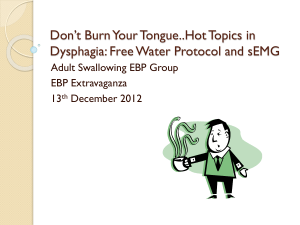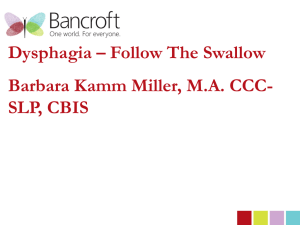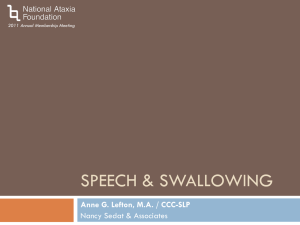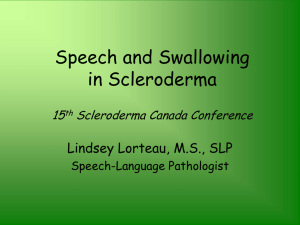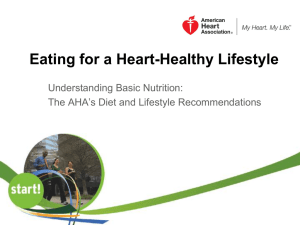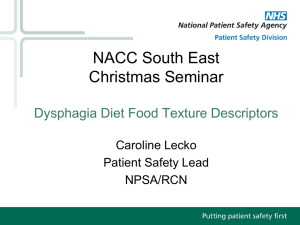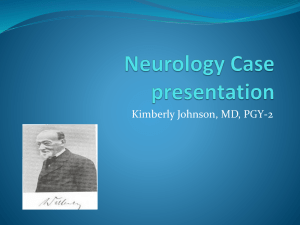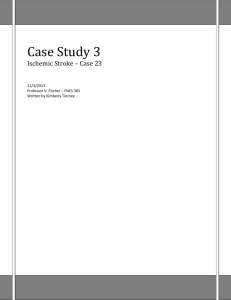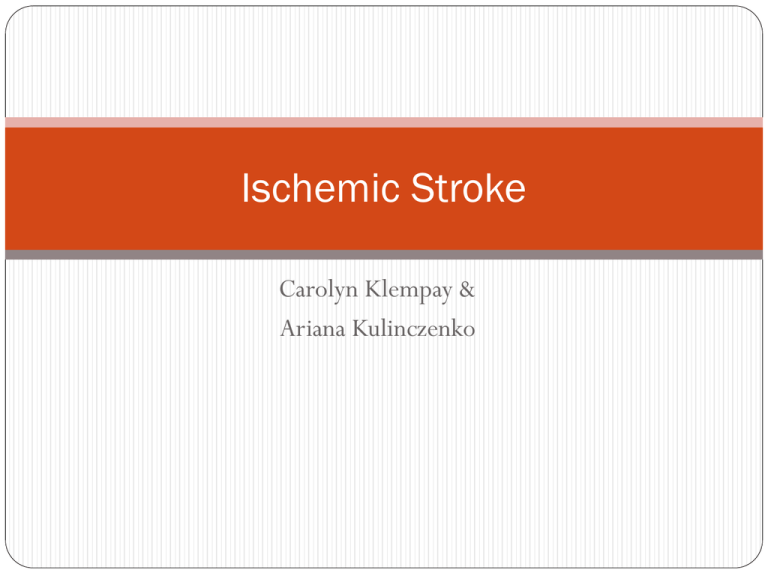
Ischemic Stroke
Carolyn Klempay &
Ariana Kulinczenko
Background
Ischemic Stroke vs. Hemorrhagic Stroke
80% of all strokes
Third leading cause of death in United States
Blood circulation stops cells die
4-10 minutes, lack of oxygen and glucose
Risk Factors
Modifiable
Unmodifiable
Hypertension
Age
Cardiovascular disease
Gender
Diabetes Mellitus
Race
Dyslipidemia
Cigarette smoking
Physical inactivity
Obesity
Diet**
Signs and Symptoms
Loss of vision or speech
Paralysis
Muscle weakness
Change in mental status
Coma, memory changes, confusion
Diagnosis
National Institute of Health Stroke Scale
Level of consciousness
Visual loss
Neurological status
Sensory loss
Language
Motor skills
CT scans and Magnetic Resonance Imaging (MRI)
Client & History
Ruth Noland
77 y.o. Female
5’2”, 165 lbs (75 kg)
Right side partial paralysis and slurred speech
Hypertension 10 years
Hyperlipidemia 2 years
BMI 30.0 kg/m2
Symptoms
Weakness of right side, arm, and leg
Impaired sensation of left side
Dysarthria and tongue deviation
Impaired cranial nerves
Loss of motor function tone and strength
Plantar reflex decreased
Normal blink reflex
Normal respiration
Diagnosis
Ischemic Stroke
NIH Stroke Scale Score 14
Intervention
Administer 0.6 mg/kg intravenous rtPA
Total dose: 67.5 mg
0.9 NS at 75 cc/hr
Check vital signs
Consciousness levels (NIH Stroke Scale)
Continuous cardiac monitoring
NPO diet 24 hours, except medications
Acetaminophen for pain treatment
Swallowing assessment
Administer dysphagia diet
Dysphagia
Dysphagia is termed as the inability or difficulty swallowing.
Swallowing is an extremely complicated process of that is
controlled by the central nervous system. It requires multiple
parts of the brain to be in cohesion.
If this area of the brain is damaged from stroke, serious
implications are necessary to follow
Difficulty swallowing can affect food consumption, due to
dehydration, malnutrition and secondary illnesses.
The primary nutrition complications are weight loss and
subsequent development of nutrition deficiencies that result
from the inadequate nutrient intake.
Bedside Swallowing Assessment
The bedside swallowing assessment was created to provide
data for use in diagnosis and treatment planning.
1. The first part is the preparatory exam with no
swallowing involved.
2. The second part is the initial swallowing exam where
the physiology of swallowing is observed.
A speech-language pathologist evaluates, performs the
diagnosis and treats swallowing disorders in the oralpharyngeal phases.
Dysphagia Swallowing Levels
A. Oral preparation: This phase is when food or liquid is chewed and
mechanically manipulated in the mouth for the preparation of swallowing.
Movement patterns in this phase depend on the consistency of the material
swallowed.
B. Oral transit: This phase is where the tongue propels food or liquid to the
back of the mouth. This is the phase that triggers the swallowing response.
Once it is pushed to the back of the mouth, the swallowing response begins.
C. Pharyngeal: This phase begins when food or liquid is quickly passed through
the pharynx and straight into the esophagus for swallowing.
D. Esophageal:This final phase is where food or liquid from the previous phases
passes through the esophagus and moves into the stomach.
Energy Requirements
TEE for Overweight and Obese Females Aged 19 Years and Older:
TEE = 448 – 7.95 x age (yrs) + PA (1.16 low active) x (11.4 x
wt (kg) + 619 x ht (m))
TEE = 448 – 7.95 x 77yrs + 1.16 x (11.4 x 75kg + 619 x 1.58m)
TEE = 1962 kcal = 1,900 kcal – 2,000 kcal
Protein Requirements:
1.0 – 1.2 g/kg body weight
1.0 g x 75 kg = 75 g
1.2 g x 75 kg = 90 g
= 75 grams – 90 grams protein
Fluid Requirements
Weight:
100 mL fluid per kg body weight for the first 10 kg
50 mL per kg body weight for next 10 kg
20 mL per kg body weight for each kg above 20kg (55kg)
Age andWeight: Standard fluid needs for people ages 65-85
years: 25-30 mL per kg
Reasonable range: 2,250 mL – 2,600 mL
Planning A Dysphagia Diet
Three levels of solid foods:
1) Pureed. These foods have a pudding-like texture and are
very cohesive. They require little to no chewing. Some
examples of the pureed level are foods similar to milk and
dairy products, applesauce, gravies and sauces.
2) Mechanically altered . These foods are very moist and are
in semisolid forms that require little chewing.
3) Advanced. These include soft foods that require a little
more chewing than the previous level. This level is usually
presented to patients with improved dysphagia.
Planning A Dysphagia Diet
Four Levels of fluid consistency:
Measured in CentiPoise; a dynamic viscosity measurement.This unit
measures the fluids force per unit or internal resistance.
1) Thin. This is 1-50 centiPoise. The thin consistency includes all
liquids, jell-o, sorbet, Italian ice and ice cream.
2) Nectar-like. This is between 51-350 cP. Examples of the nectar
phase include an apricot juice consistency.
3) Honey-like. This is between 351-1,750 cP. This includes liquids
that can still be poured, but very slowly.
4) Spoon-thick. This is greater than 1,750 cP and includes liquids
that are spoon-able that will not stay upright when a spoon is held
vertically.
Foods in the Dysphagia Diet
To maintain or attain normal nutritional status while reducing danger of aspiration and
choking, the texture (of foods) and/or viscosity (of fluids) are personalized for a patient
with dysphagia.
1) Consistency
The uniformity and coherence among things or parts within a food or substance
Pureed Consistency in a dysphagia diet. Pureed is described as smooth and
pudding-like. Ex: applesauce, gravies, pudding.
2) Texture
The composition or structure of a food or substance
Adding corn flour to a substance to create a more gritty and thicker texture
3) Viscosity
The resistance to flow or alteration of shape by any substance as a result of
molecular cohesion
Applied to the resistance liquids have when swallowed, of a fluid to flow
because of a shearing force. Ex: Honey-like 351-1750cP
Dysphagia Diet
Mrs. Noland’s dysphagia is centered in the esophageal
transit phase.
She is having trouble passing food from the esophagus to the
stomach. Mrs. Noland is experiencing reduced esophageal
peristalsis, which indicates she cannot handle foods of thick
consistencies.
For food to pass through to the stomach, Mrs. Noland will
need to stick to a pureed and thin liquid diet because liquids
have the quickest transit time.
Mrs. Noland’s Altered Diet
Orange Juice: no pulp
Raisin Bran: cream of wheat, breakfast cereal, warm and pureed, easily swallowed
Milk: thin liquid
Banana: pureed until completely smooth
Coffee: thin liquid
Sweetener: dissolve in the liquid and can be swallowed with the liquid
Chicken Tortellini soup: puree the entire soup and strain
Saltine Crackers: puree this with her soup and strain
Canned Pears: substitute with applesauce or puree the pears for easier swallowing
Iced Tea: thin liquid
Baked Chicken: mix with liquid and puree
Baked Potato: mashed
Steamed broccoli: puree or substitute with vegetable juice or v8
Margarine: acceptable
Canned Peaches: puree, thin fruit smoothie, substitute for a fruit pudding, or
yogurt.
Enteral Products
Mrs. Noland should also consider a nutritional
supplement, such as nutritional shakes, Ensure
High Protein, to ensure proper and sufficient
nutrient and energy intake. Mrs. Noland needs a
nutritional supplement drink that provides an
adequate amount of protein because it will be
difficult for her to include high protein foods in
her diet.
No consumption of: pulp, cottage cheese, eggs,
peanut butter, nuts or seeds
Ensure High Protein Nutrition Shake Milk Chocolate : 1
serving: 414 mL, 210 kcal, 25 g protein, 2.5 g Fat, 23 g
Carbs, 3 g Fiber .
Nutrition Upon Discharge
Mrs. Noland will still struggle with many problems once she is
released from the hospital. It is important for her husband to be
aware of these potential conditions to prevent problems from
occurring or worsening. Mrs. Noland will still be struggling to
swallow many foods and will need to eat very soft foods, with a
pureed consistency.
She will slowly be able to make progress to denser foods with
thicker consistencies, but that progress will be very gradual and
cannot be implemented until her speech pathologist allows her.
Mr. and Mrs. Noland should go through nutrition counseling so
that they may become educated over proper nutrition, preparation
and purchasing techniques that will aid in her recovery and
prevent a future stroke from occurring.
Lab Data
Chemistry
Normal Range
August 12
Cholesterol (mg/dL)
120-199
210
HDL-C (mg/dL)
>55
40
LDL (mg/dL)
<130
155
LDL/HDL ratio
<3.22
3.875
Triglycerides (mg/dL) 35-135
198
PES Statements
1. Obesity (NC-3.3) related to excessive energy intake and physical
inactivity as evidence by BMI of 30.0 kg/m2, elevated cholesterol
levels of 210 mg/dL, low HDL of 40 mg/dL, high LDL of 155
mg/dL, elevated LDL/HDL ratio at 3.875, elevated triglyceride
levels at 198 mg/dL, relation to hypertension development, and
infrequent physical activity.
2. Excessive Fat Intake (NI-5.6.2) related to food and nutrition-
related knowledge deficit as evidence by elevated cholesterol levels
of 210 mg/dL, low HDL of 40 mg/dL, high LDL of 155 mg/dL,
elevated LDL/HDL ratio at 3.875, elevated triglyceride levels at 198
mg/dL, hyperlipidemia, and BMI at 30.0 kg/m2.
Goals
Acute Period:
Initiate dysphagia diet, pureed foods and thin liquids
Maintain energy intake 1,800 kcal – 2,000 kcal
Weight maintenance, appropriate calorie, protein, and fat levels
Initiate (minimum) 5 cups fluid to meet fluid requirements
Nutrition education to client and husband on dysphagia diet
Record weight changes, hydration status, and fluid loss
Add enteral nutrition supplement product, rich in protein
Goals
Post-Rehabilitation:
Use adjusted weight to initiate weight reduction
Initiate 1,600 kcal – 1,800 kcal energy intake
Decrease fat intake (31%), increase protein intake (14%)
Initiate physical activity
Monitoring & Evaluation
Track food intake and evaluate food log
Track foods she has difficulties swallowing and which are
easily consumed, so that they can either be continued or
discontinued in her diet
Monitor fat levels and reassess lipid profile to see if any
improvements have been made
Protein intake
Appetite and tolerance
Weight, to determine whether her intake is sufficient.
Recommendation of admission to a stroke rehabilitation
center should be considered
Questions?
Resources
Anatomy & Physiology of Swallowing. (2011). Anatomy & Physiology of
Swallowing. Retrieved November 25, 2013, from
http://www.d.umn.edu/~mmizuko/5200/anat.htm
Chidester, J. (1997, June). Result Filters. National Center for Biotechnology
Information. Retrieved December 1, 2013, from
http://www.ncbi.nlm.nih.gov/pubmed/8990413
Clinic, M. (2012, July 3). Definition. Mayo Clinic. Retrieved November
12, 2013, from
http://www.mayoclinic.com/health/stroke/DS00150/DSECTION=tr
eatments-and-drugs
Definition: 'Viscosity'. (2006). Viscosity. Retrieved December 1, 2013,
from http://www.medilexicon.com/medicaldictionary.php?t=99155
Dysphagia. (2013). Dysphagia. Retrieved December 1, 2013, from
https://ehealth.gov.mt/HealthPortal/rehabilitation/speech_language_
pathology/conditions_that_may_affect_sl/dysphagia.aspx
Resources
Heart Association. (2012, December 10). What Your Cholesterol Levels Mean.
WhatYour Cholesterol Levels Mean. Retrieved November 24, 2013, from
http://www.heart.org/HEARTORG/Conditions/Cholesterol/AboutCholeste
rol/What-Your-Cholesterol-Levels-Mean_UCM_305562_Article.jsp
Nelms, M. N. (2013). Nutrition Therapy and Pathophysiology 2/e. Belmont, CA,
Wadsworth.
NIH. (2011). NIH Stroke Scale. National Institutes of Health. Retrieved
November 12, 2013, from
http://www.nihstrokescale.org/docs/HospitalStrokeScales.pdf
Office of the Professions. (1998, January). NYS Speech-Language Pathologists &
Audiologists: Fiberoptic Endoscope. Retrieved December 1, 2013, from
http://www.op.nysed.gov/prof/slpa/speechguidefiberoptic.htm
U.S. Bureau of Labor Statistics. (2013, November 20). U.S. Bureau of Labor
Statistics. Retrieved November 30, 2013, from http://www.bls.gov/

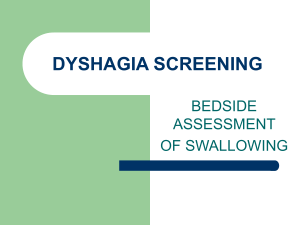
![Dysphagia Webinar, May, 2013[2]](http://s2.studylib.net/store/data/005382560_1-ff5244e89815170fde8b3f907df8b381-300x300.png)

